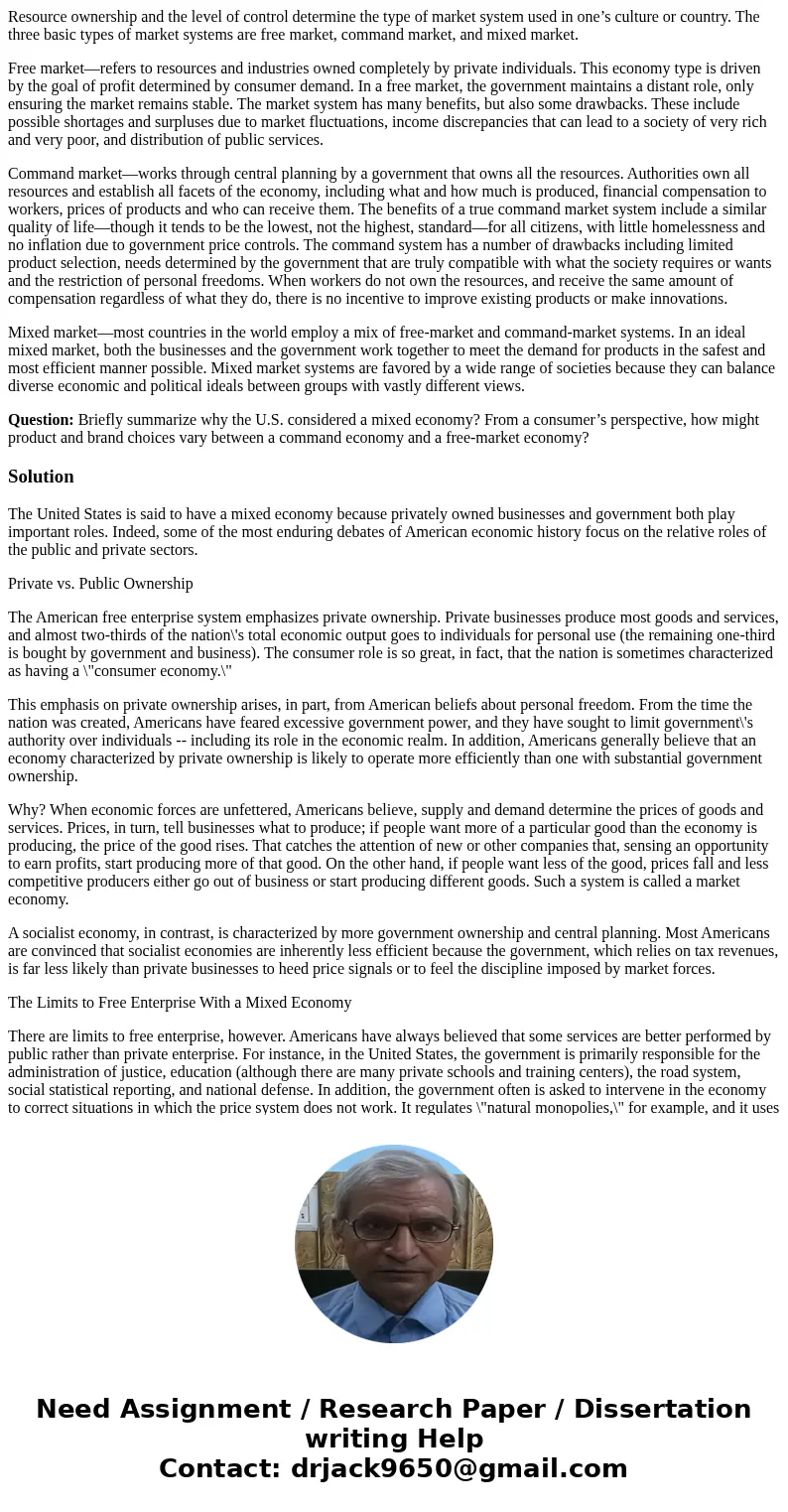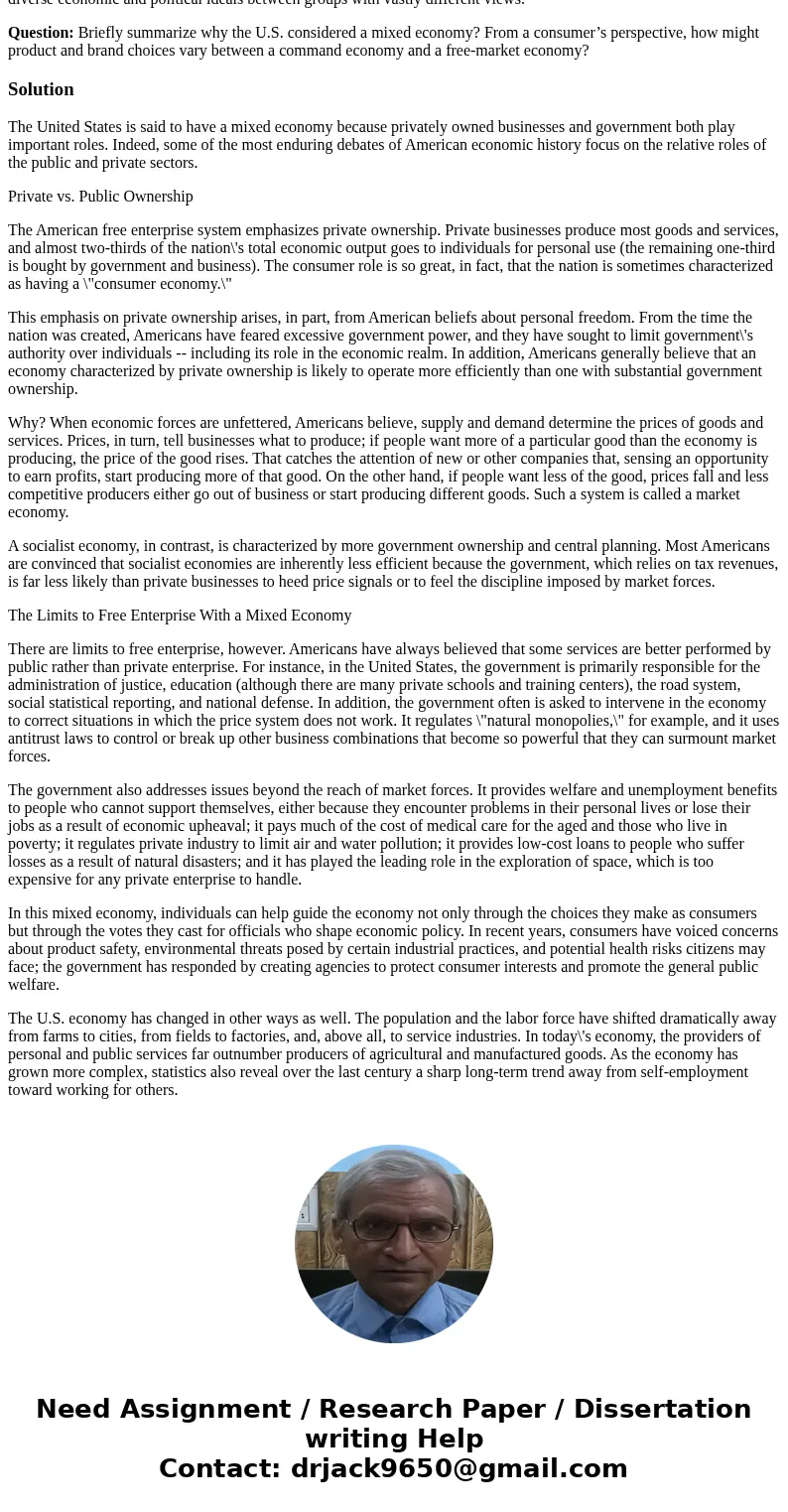Resource ownership and the level of control determine the ty
Resource ownership and the level of control determine the type of market system used in one’s culture or country. The three basic types of market systems are free market, command market, and mixed market.
Free market—refers to resources and industries owned completely by private individuals. This economy type is driven by the goal of profit determined by consumer demand. In a free market, the government maintains a distant role, only ensuring the market remains stable. The market system has many benefits, but also some drawbacks. These include possible shortages and surpluses due to market fluctuations, income discrepancies that can lead to a society of very rich and very poor, and distribution of public services.
Command market—works through central planning by a government that owns all the resources. Authorities own all resources and establish all facets of the economy, including what and how much is produced, financial compensation to workers, prices of products and who can receive them. The benefits of a true command market system include a similar quality of life—though it tends to be the lowest, not the highest, standard—for all citizens, with little homelessness and no inflation due to government price controls. The command system has a number of drawbacks including limited product selection, needs determined by the government that are truly compatible with what the society requires or wants and the restriction of personal freedoms. When workers do not own the resources, and receive the same amount of compensation regardless of what they do, there is no incentive to improve existing products or make innovations.
Mixed market—most countries in the world employ a mix of free-market and command-market systems. In an ideal mixed market, both the businesses and the government work together to meet the demand for products in the safest and most efficient manner possible. Mixed market systems are favored by a wide range of societies because they can balance diverse economic and political ideals between groups with vastly different views.
Question: Briefly summarize why the U.S. considered a mixed economy? From a consumer’s perspective, how might product and brand choices vary between a command economy and a free-market economy?
Solution
The United States is said to have a mixed economy because privately owned businesses and government both play important roles. Indeed, some of the most enduring debates of American economic history focus on the relative roles of the public and private sectors.
Private vs. Public Ownership
The American free enterprise system emphasizes private ownership. Private businesses produce most goods and services, and almost two-thirds of the nation\'s total economic output goes to individuals for personal use (the remaining one-third is bought by government and business). The consumer role is so great, in fact, that the nation is sometimes characterized as having a \"consumer economy.\"
This emphasis on private ownership arises, in part, from American beliefs about personal freedom. From the time the nation was created, Americans have feared excessive government power, and they have sought to limit government\'s authority over individuals -- including its role in the economic realm. In addition, Americans generally believe that an economy characterized by private ownership is likely to operate more efficiently than one with substantial government ownership.
Why? When economic forces are unfettered, Americans believe, supply and demand determine the prices of goods and services. Prices, in turn, tell businesses what to produce; if people want more of a particular good than the economy is producing, the price of the good rises. That catches the attention of new or other companies that, sensing an opportunity to earn profits, start producing more of that good. On the other hand, if people want less of the good, prices fall and less competitive producers either go out of business or start producing different goods. Such a system is called a market economy.
A socialist economy, in contrast, is characterized by more government ownership and central planning. Most Americans are convinced that socialist economies are inherently less efficient because the government, which relies on tax revenues, is far less likely than private businesses to heed price signals or to feel the discipline imposed by market forces.
The Limits to Free Enterprise With a Mixed Economy
There are limits to free enterprise, however. Americans have always believed that some services are better performed by public rather than private enterprise. For instance, in the United States, the government is primarily responsible for the administration of justice, education (although there are many private schools and training centers), the road system, social statistical reporting, and national defense. In addition, the government often is asked to intervene in the economy to correct situations in which the price system does not work. It regulates \"natural monopolies,\" for example, and it uses antitrust laws to control or break up other business combinations that become so powerful that they can surmount market forces.
The government also addresses issues beyond the reach of market forces. It provides welfare and unemployment benefits to people who cannot support themselves, either because they encounter problems in their personal lives or lose their jobs as a result of economic upheaval; it pays much of the cost of medical care for the aged and those who live in poverty; it regulates private industry to limit air and water pollution; it provides low-cost loans to people who suffer losses as a result of natural disasters; and it has played the leading role in the exploration of space, which is too expensive for any private enterprise to handle.
In this mixed economy, individuals can help guide the economy not only through the choices they make as consumers but through the votes they cast for officials who shape economic policy. In recent years, consumers have voiced concerns about product safety, environmental threats posed by certain industrial practices, and potential health risks citizens may face; the government has responded by creating agencies to protect consumer interests and promote the general public welfare.
The U.S. economy has changed in other ways as well. The population and the labor force have shifted dramatically away from farms to cities, from fields to factories, and, above all, to service industries. In today\'s economy, the providers of personal and public services far outnumber producers of agricultural and manufactured goods. As the economy has grown more complex, statistics also reveal over the last century a sharp long-term trend away from self-employment toward working for others.


 Homework Sourse
Homework Sourse